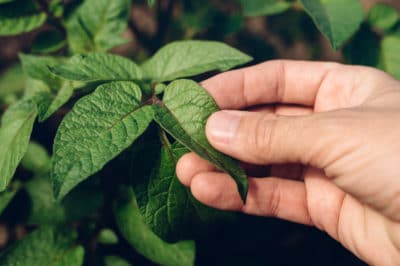Potato Vines
The stem of a potato plant begins in the tuber itself. The eyes – small depressions – in the surface of the potato sprout and develop leaves. Once the potatoes are planted, these stems or stolons will develop tubers along their underground length. In full sun, potatoes may grow a foot to 18 inches above ground, but if located in shade, they may become more vine-like and sprawl two or three feet over the ground.
Water and Nutrients
No plant will grow well without adequate nutrients and water; potatoes are no exception. During the growing period, potato vines need a constant source of moisture but can’t handle soggy soil. Irrigate enough to keep the soil just damp. Potatoes are heavy feeders that need large quantities of nitrogen and potassium as well as micronutrients. Use a balanced organic fertilizer or good compost every month.
Hilling Potato Vines
The practice of hilling – covering potatoes with loose soil – is one way in which gardeners treat potato vines differently. Since potatoes develop tubers all along the stem, hilling can increase the number of tubers the plant sets. Hilling also keeps light from reaching the tubers. Tubers exposed to sunlight turn green and become inedible because they develop higher amounts of solanine, a toxic alkaloid.
Insect Pests
Potato vines are susceptible to a variety of insect attacks. Healthy plants can often withstand a little damage, however. Controls differ depending on the insect. Here are some common potato pests:
- Aphids – spray with insecticidal soap
- Red Spider Mites – neem oil; beneficial insects
- Leafhoppers – use resistant varieties; pyrethrum sprays
- Colorado potato beetle – plant early varieties; hand pick insects.
Pinching and Pruning
With most vines, you must pinch or prune to control growth. You can do the same for potatoes. Pruning the vines can promote earlier maturity. Once the vines begin to die off, you should prune them to allow the tubers to mature completely. You can also pinch off blossoms so the plant will not spend energy in flower and seed development.
Potato Vine Basics
In addition to the above, follow the basics for growing healthy potatoes. Make sure your soil is loose and friable to promote healthy tuber development. Always grow potatoes in full sun. Plant at the right time for your climate and growing conditions. Once you harvest, cure the tubers in a dark, well-ventilated area for two weeks to increase storage life. Don’t wash potatoes after harvest – it increases the chance of rot.
